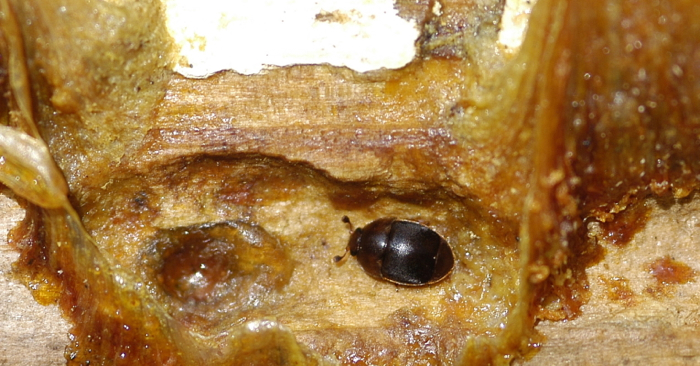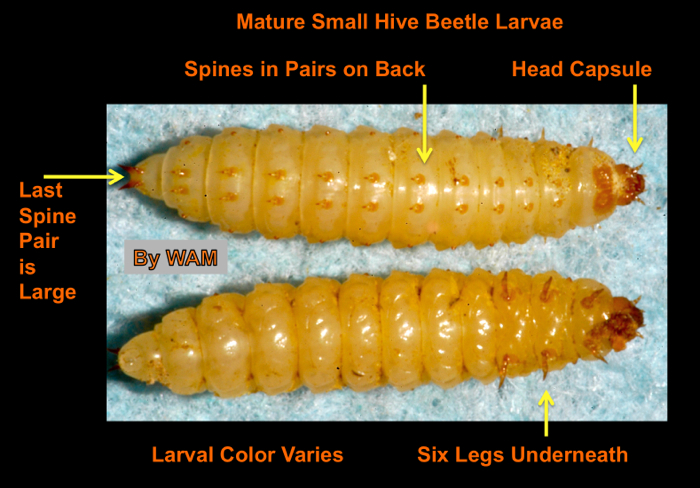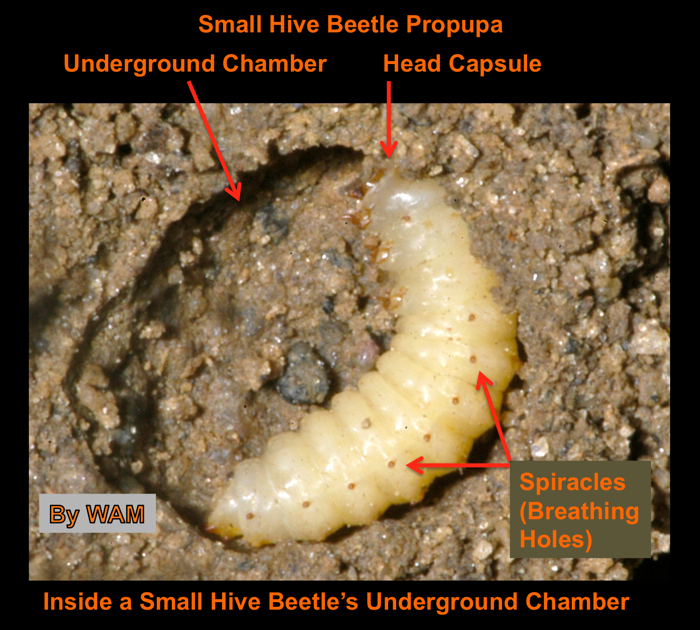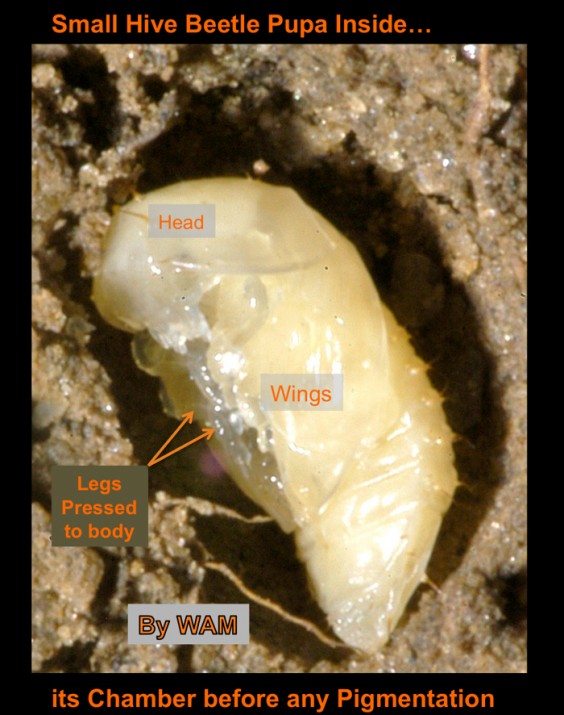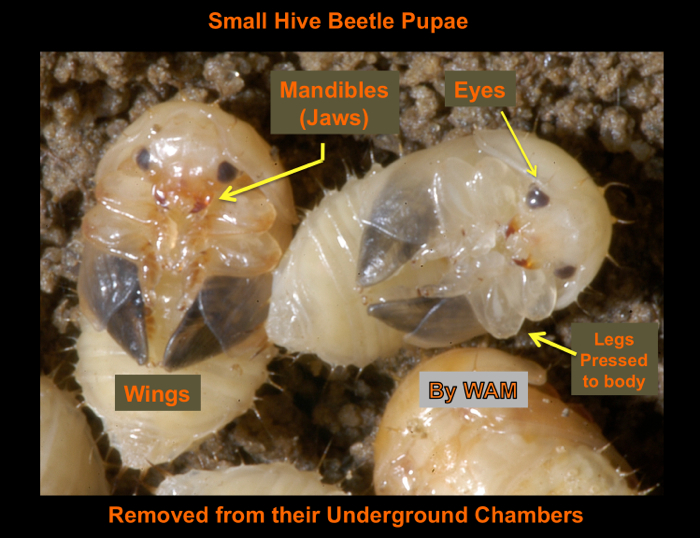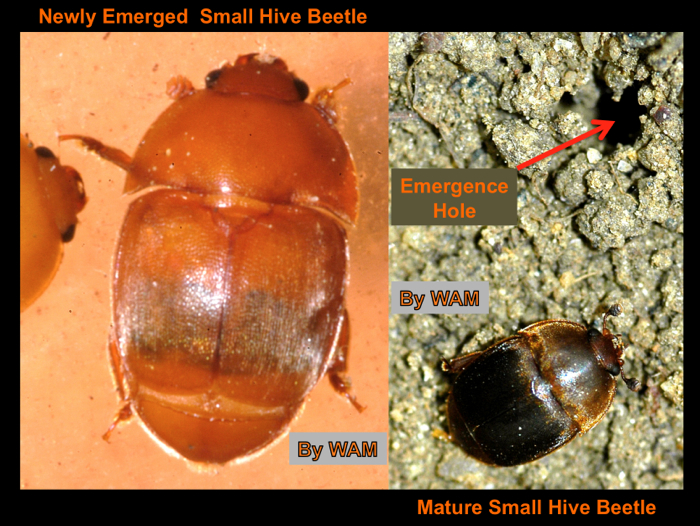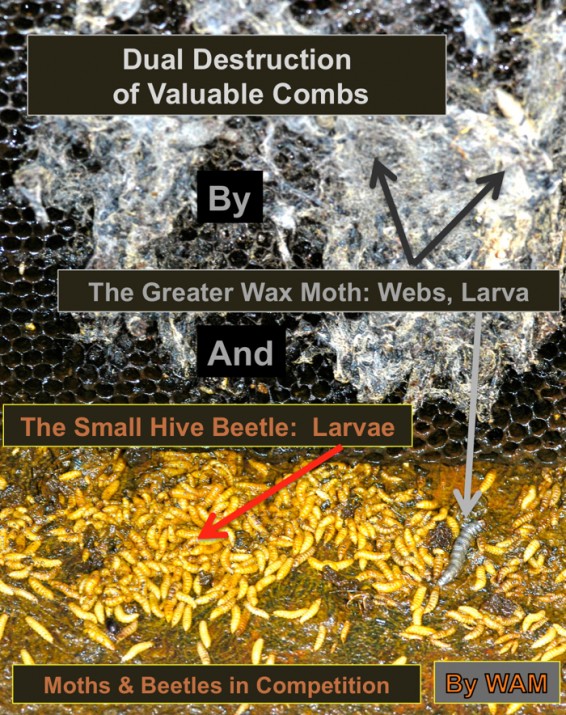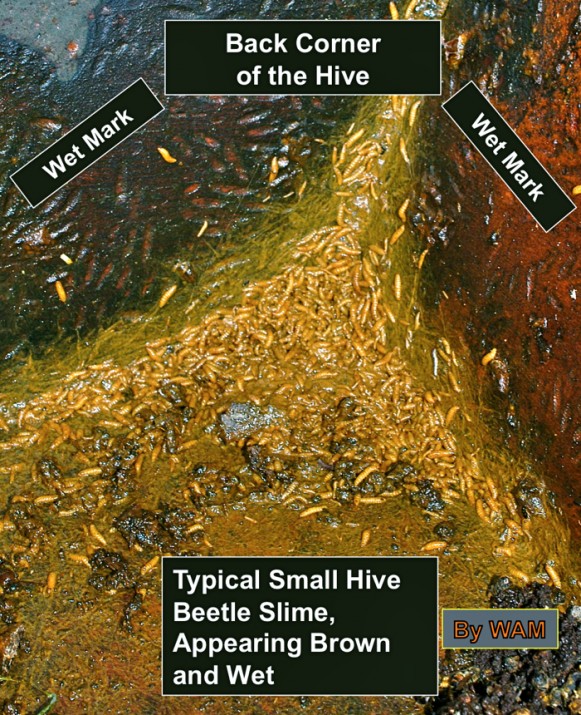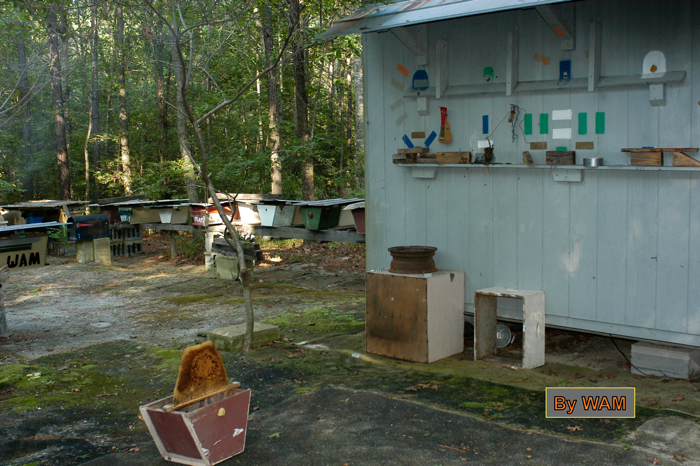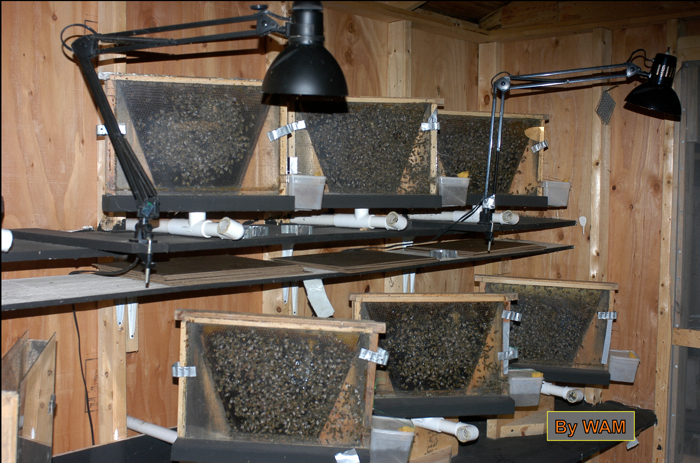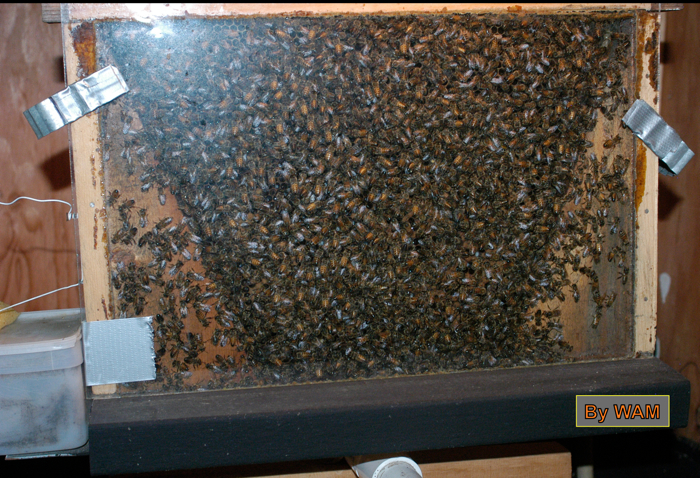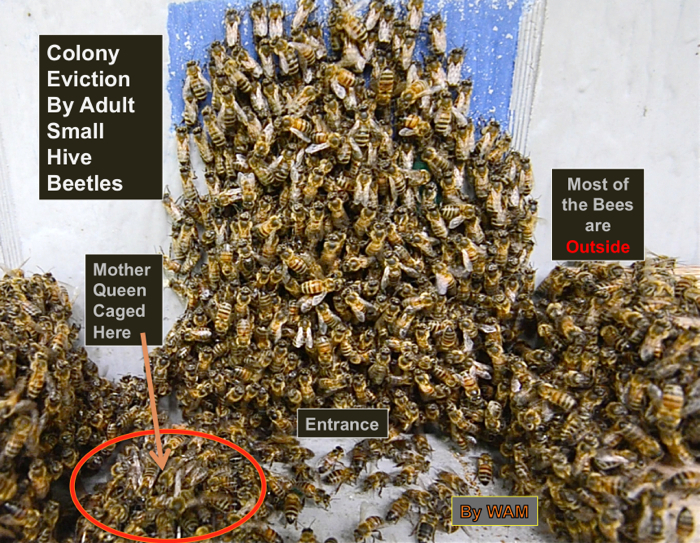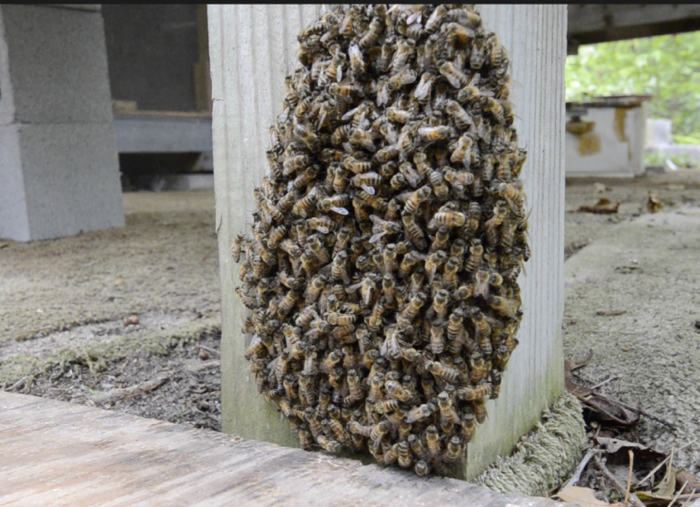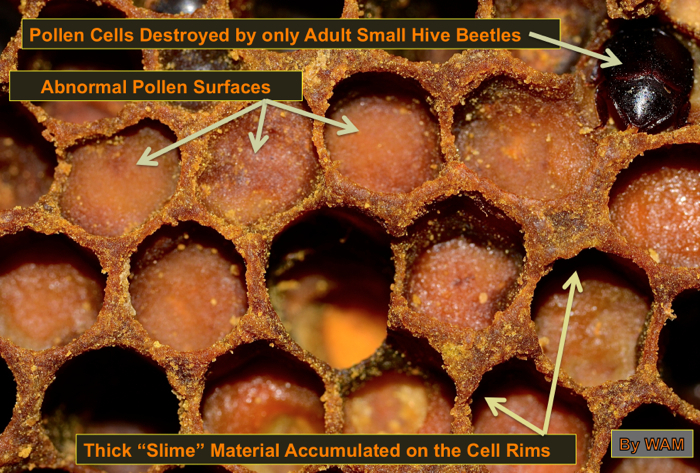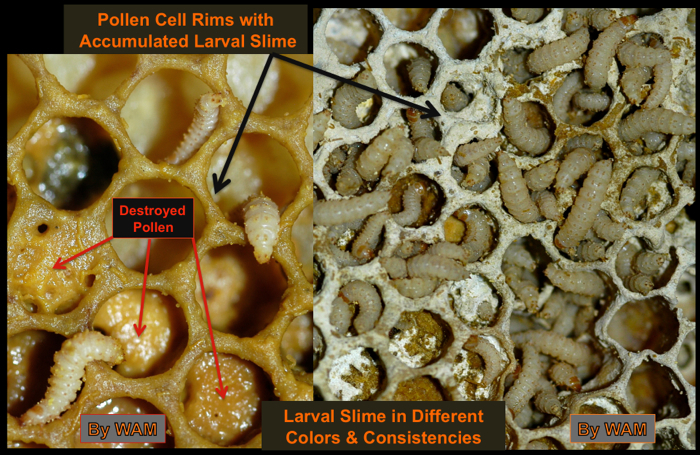Small Hive Beetles
Small Hive Beetles
Beekeepers need to be aware of small hive beetles, especially if the pests are endemic in their local areas. In my location of Piedmont Virginia, I regard small hive beetles as more of a problem than the greater wax moths. Quite often the beetles will out compete the wax moths for unprotected comb in weak colonies.
Let’s begin by reviewing how to identify adult small hive beetles. Usually the adult beetles are black in with small antennae with little knobs on their ends. Below is an adult beetle in a corral of propolis (bee glue) used here to restrict their movement in the hive.
Small Hive Beetles Corralled or Imprisoned by the Bees
Typically with a strong colony covering its combs, small hive beetles are found in the upper corners of the hive. The worker bees keep the adult beetles corralled off the comb or restricted to the edges of the comb in empty cells, well away from the brood nest unless something is wrong.
Here is a movie clip of bees keeping small hive beetles in a restricted space. The wire is a queen introduction cage forming a small gap next to the glass of an observation hive. Notice the beetles can be fairly aggressive at confronting the bees, perhaps to solicit food from the bees.
Small Hive Beetles Fed by the Bees
The bees guarding the small hive beetles actually feed them, essentially “tricked” by the beetles. Here is a remarkable movie clip I shot of two feeding events of a small hive beetles being fed by bees. Watch the mouth parts of the two, bee and beetle, coming together as I adjust the manual focus of the camera. (I cannot use automatic focus because of the glass.) Two feeding events occur, the first in the upper right of the screen and then in the lower right. I use this clip in my presentations at bee meetings so the feeding events do not occur immediately while I tell the audience the set up for just a bit.
Small Hive Beetle Larval Identification
Beekeepers need to be aware that other adult beetles, resembling small hive beetles, can be found in hives in the United States. These are not small hive beetles. They are probably just scavenger beetles, which have always been in the hives, passing unnoticed for decades, before beekeepers became sensitive to finding small hive beetles.
Not only can the adult small hive beetles be confused with other beetles, small hive beetle larvae can be confused with wax moth larvae. However small hive beetle larvae have some distinguishing characteristics. The beetle larvae have little spines down their backs, which wax moth larvae lack. The beetle larva has a well-defined head capsule and legs. The beetle larvae are creamy white in color, but sometimes they appear in shades of light brown if they have been crawling through the slime they produce. Below is a detailed picture of the back and underside of a small hive beetle larva.
Sometimes fly larvae occur in hives, particularly if rotting brood is present as a colony dies. However, fly larvae appear different from small hive beetle larvae (various taxonomic details). If you find suspicious larvae in the hive, get a qualified person to make the determination, especially if small hive beetles have not been reported in your area.
Immature small hive beetle larvae shun the light and hide from bees. Even if one cannot find small hive beetle larvae in the combs of a colony, check under any trash that may have accumulated on the bottom board (the floor) of the hive. This next movie clip shows me uncovering dozens of small hive beetles using a hive tool as a rake, but first comes a heavily infested comb of beetle larvae crawling through their slime.
Click here to see small hive beetle larvae.
Small Hive Beetle, Underground Development
Mature larvae become attracted to light and crawl out of the hive. I have observed them leaving in the afternoon in a shaded apiary. Beetle larvae are reported to leave the hive in the evening too. Coming out of the hive, they fall on the ground and bury themselves into the dirt. Most of the larvae enter the soil within a few feet of the hive and dig down several inches.
After forming a small underground chamber, a small hive beetle larva becomes motionless as shown below in my close up photograph.
In the chamber, the larva changes into a beetle pupa. At first the pupa is white, as shown below.
Then its different body parts darken as the beetle matures, as seen below.
Upon completing the pupal stage, a new adult beetle digs its way out of the soil, leaving a small emergence hole, which under field conditions is virtually impossible to detect (but see below, in the right picture). Newly emerged beetles are a light reddish brown (left picture below) and gradually darken to black with age. Black, however, is the most frequent pigmentation.
Keeping colonies strong is the general recommendation for protecting them from small hive beetle invasion of their brood combs. However in the current complicated world of bee management, plagued with miticide-resistant varroa mites, hindered by failing queens, fraught with bee diseases and pesticides, keeping colonies strong is difficult.
Small Hive Beetle populations may flare up at the worst possible times when the colonies are weak and vulnerable – hence my recommendation for routine colony inspections, about once a month. Those inspections should continue all through the summer dearth.
A colony inspection should go down to seeing the trash, if any, on the bottom boards. Just look on the hive floor when a couple of frames are out of the brood chamber because beetle larvae hide in the trash as shown in the movie clip above. Make sure the brood nest size is adequate for the nectar flow conditions, figured from past seasonal experience and observing the currently healthy brood nests of other colonies. Let-a-lone, “lazy,” and let-nature-take-its course so-called “beekeeping” methods are not appropriate in these complicated times of small hive beetles, varroa mites, etc.
When colonies become weak in the summer, expect the appearance of beetle larvae, particularly in areas where this pest becomes numerous. Below we see a colony that became weak in summer heat.
Notice there are no bees on the comb. The colony population decreased and the bees were in another part of the hive. That exposed some combs meaning they lacked patrolling bees to keep out the pests. Small hive beetle larvae quickly invaded the exposed comb. Many beetle larvae congregated on the hive floor too as seen above. Greater wax moth webs (and larvae) were also in the combs as seen above. Both larval insects were in competition for the comb contents as food for reproduction.
Without beekeeper intervention, thousands of small hive beetle larvae amass in the hive away from the light. The material that appears slick and shiny is the slime the beetle larvae produce. This slime also appears on the combs, a contamination by the larvae. Below are small hive beetle larvae in the corner of the hive.
My rule is not to keep colonies in the summer that are weak. I unite weak colonies with other weak colonies or to strong colonies, depending on the original cause of the colony becoming weak (another subject). During the summer dearth period, I watch for surges of small hive beetles immigrating into my apiaries during colony inspections. The beetles could be emerging from the ground in large numbers near colonies dying through the summer. That beetle surge could be from a neglected apiary, or it could be from dying feral colonies (bee trees) spewing out thousands of larvae. (I have seen that.) So now small hive beetle immigration is part of the bee management year for regions with the pest.
Small Hive Beetle Adults (only) Evict an Entire Colony
Below is a stunning version of adult small hive beetle immigration, moving the pest from a secondary invader to a primary cause of colony destruction, of at least small observation colonies (which could be roughly the size of mating nucs). In the typical scenario, a small hive beetle population builds up in the hive with hundreds of larvae as seen above in the pictures and close-up movie clip of the comb. The colony may even abscond. Here large numbers of beetles immigrated in the observation hives and forced the eviction of the bees with no or very little larval production.
Here is where this beetle immigration occurred. I had planned some queen introduction experiments in my bee house, which can hold 30 single-comb top-bar observation hives. Below is a corner of the bee house (more information is in my top-bar hive book) taken one day when I was conducting other work. The color markings on the wall help the bees mark their entrance locations.
Usually I have 20 – 30 full-size colonies around the bee house, which I use for queen rearing and other projects. Last summer my out-apiaries had all the full size colonies. I was running only about eight observation hive colonies, which became the only locations for the small hive beetles to find. Here is a photograph of a couple of tiers of observation hives from some other investigations.
A typical top-bar observation hive colony is below.
By that July, my best observation colonies were queen right and covering their combs with normal brood nests and old enough from the spring to be in a “stable” age distribution. In many respects, these observation colonies function like a miniature version of a large colony.
The first big symptom of a problem came with too many bees clustered around the entrance of one of the observation hives. Then I saw the clincher of a problem. The mother queen of the observation colony – forced off her brood nest by something. (She was heavily laden with eggs, that is, mother queen.) I figured whatever could force a mother queen to abandon her brood nest and send her roaming about outside had to be bad, terribly bad, and it was. Below is one of the evictions before the bees tried to abscond. I have the queen caged at the lower left of the picture. Bees covered the cage.
I only had to look in the observation hive, simple enough. Small hive beetles had invaded this colony in large numbers. An estimated count from another observation colony was around 150 adult beetles, a lot for a single comb. There were no larvae. Keep in mind initially these colonies covered their combs with normal brood nests, including pollen and honey bands. Here is a movie clip showing a colony few days before eviction, then going outside the bee house to see the entrance of the glass hive.
The colony in the video above absconded, and I found it by my bee house on a post. The swarm was low to the ground and close to the hive’s entrance because the queen could not fly.
Other colonies, still on their combs, had pollen bands with even more numerous adult beetles in the pollen cells. Initially, the adult beetles made a thick pollen “slime,” which had a “dryer” consistency than the typical wetter larval slime or as seen in the video. The adult beetles move among pollen-loaded cells and damage them in two obvious ways: first the surface of the pollen in the cell (as shown below) appeared to change and the bees probably stopped consuming. Note the change in the pollen surface.
If the bees stop eating the pollen, that would halt the protein flow into the young adult bee subpopulation, which produces worker jelly, etc., to feed the brood, and generally would injure adult bees in other protein dependent ways. The second problem appears to begin with the adult beetles going over the cell walls repeatedly as they shift between adjacent cells. As the beetles go over the cell wall, it appears an excess of “slimed” pollen accumulates on the cell rims, bulging them as shown in the photograph above.
With bees in a dark hive, we do not know much about the importance of cell rims, but the bees’ intimate contact with cell rims would seem to have evolved some importance. At any rate, the loss of normal contact with pollen cell rims and its replacement by a “foreign” material could very well aid in colony eviction, but now just by the adult beetles. A similar accumulation of material occurs on the rims of pollen cells when small hive beetle larvae cause the eviction of bees as shown in pictures below from large hives (not the observation hives).
I will continue adding small hive beetle material as photographic and filming opportunities occur. A bee house with numerous observation hives can reveal details that beekeepers may not get a chance to see.
Please consider donating to support these pages by clicking on the button below and entering credit card or debit card information. Paypal handles all the security. Thank you.
